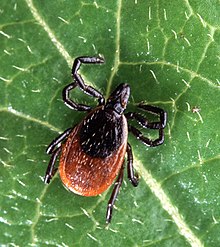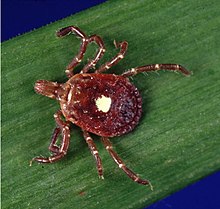The good news is that not every tick is infected, but the bad news is that the CDC says that there are 14 known tick-borne diseases in the United States, and possibly 15 (if newly discovered Bourbon virus is included). Lyme disease is the most common, but people can be infected with more than one tick-borne illness simultaneously. Three new diseases to watch for: Borrelia miyamotoi (bacteria carried by deer ticks), Heartland virus (carried by Lone Star Tick), and Bourbon virus. From Medical Xpress;
Beyond Lyme, new illnesses, more reason to watch for ticks
Lyme disease makes the headlines but there are plenty of additional reasons to avoid tick bites. New research highlights the latest in a growing list of tick-borne threats—a distant relative of Lyme that's easy to confuse with other illnesses.Monday's study suggests a kind of bacteria with an unwieldy name—Borrelia miyamotoi—should be on the radar when people in Lyme-endemic areas get otherwise unexplained summertime fevers. It's one of several recently discovered diseases linked to ticks in different parts of the country, a reminder to get tick-savvy no matter where you live.
The first U.S. case was reported in 2013 in New Jersey, an 80-year-old cancer survivor who over four months became increasingly confused, had difficulty walking and lost 30 pounds. Doctors found spiral-shaped bacteria in her spinal fluid that looked like Lyme but caused a relapsing fever more closely related to some other tick-borne illnesses. While treatable by antibiotics—the woman recovered—doctors know little about B. miyamotoi.
Researchers with Imugen Inc., a Massachusetts testing lab, tested blood samples from patients in Massachusetts, Rhode Island, New Jersey and New York whose doctors suspected tick-borne illnesses and used that lab. During the 2013 and 2014 tick seasons the lab found 97 cases of the new infection. That's roughly 1 percent of samples tested and close to the lab's detection of a better-known tick disease named anaplasmosis. ...Researchers then analyzed medical records from 51 of those patients, and found symptoms typically include a high fever, severe headache, chills and blood abnormalities—decreases in infection-fighting and blood-clotting cells.
The bacterium is carried by deer ticks, also known as blacklegged ticks, which also can spread Lyme and two other illnesses, babesiosis and anaplasmosis.
Then there's the Bourbon virus, with similar symptoms, discovered last year after the death of a Kansas man and named for his home county. Another patient, in Oklahoma, recovered. The Kansas man had found an embedded tick days before getting sick, and CDC researchers are searching for the culprit species.
The CDC counts 14 illnesses linked to specific U.S. tick species, not including the Bourbon virus still being studied. Lyme is the most common, with about 30,000 cases reported each year, although CDC has estimated that the true number could be 10 times higher. It's too early to know how widespread the newly discovered illnesses are. But people can be infected with more than one tick-borne illness simultaneously, complicating care.
 Deer tick
Deer tick  Lone Star Tick Credit:Wikipedia
Lone Star Tick Credit:Wikipedia
